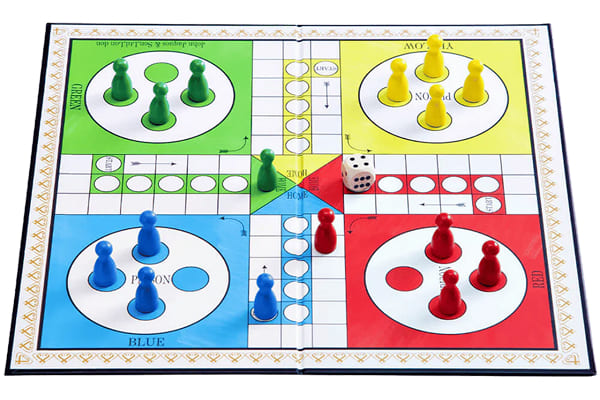Ludo

Ludo
A lighthearted race of luck, timing, and player interaction — perfect for families, kids, and nostalgic adults.
Ludo is a classic roll-and-move game built on anticipation and reaction. Easy to teach and play, it’s ideal for relaxed sessions with friends or family. Don’t let the simplicity fool you — smart movement and reading your opponents can swing the outcome.
How to Play Ludo
Ludo is a simple turn-based race game where players try to move all their tokens from the start area to the home base — avoiding elimination by opponents along the way. Here’s how it works:
- Setup: Each player picks a color and places four tokens in their matching starting area.
- Objective: Move all four of your tokens from base to home by completing a full loop around the board.
- Starting: You need to roll a six to bring a token onto the board.
- Movement: On your turn, roll a die and move one of your tokens forward that many spaces.
- Rolling a Six: If you roll a six, you get another turn — and may enter another token into play.
- Capturing: If your token lands on an opponent’s token, their token is sent back to base.
- Safe Spaces: Some marked spots are “safe zones” where tokens can’t be captured.
- Winning: The first player to get all four tokens to their home column wins.
➤ House rules may include changes like "only one extra roll on six" or "multiple captures in one turn." These are covered below.
Core Mechanics
Ludo may appear simple, but it’s built on timeless mechanics that blend tension, risk, and interaction. Here’s what drives the gameplay.
🎲 Dice-Based Movement
Every action begins with a die roll. While luck plays a role, smart decisions — like which token to move — add subtle strategy to each turn.
🔁 Entering & Cycling Tokens
Players must choose when to bring new tokens into play vs. advancing existing ones. Timing your entries can control tempo and threat.
⚔️ Capture & Avoidance
Landing on opponents sends their tokens back to base — a simple yet impactful form of conflict. Reading threats and avoiding hotspots is essential.
🏁 Race & Blocking
It’s a race to the finish, but strategic blocking (positioning tokens to slow others) adds a layer of defense and positioning play.
🛡️ Safe Zones
Certain spaces protect tokens from being captured. Knowing when to rest in safety or rush ahead creates dynamic tension in close games.
Beginner Tips
Ludo is easy to learn — but making the right moves at the right time can mean the difference between a quick exit and a surprising win. Here are a few tips to help new players enjoy their early sessions:
-
1. Always bring tokens out when possible.
The more tokens you have in play, the more choices you’ll have each turn. Holding back limits your options. -
2. Use sixes to your advantage — but plan ahead.
Rolling a six is powerful: you can enter new tokens and take extra turns. But avoid rushing into danger zones just because you can. -
3. Learn to recognize "capture traps."
Be cautious near opponent tokens that can catch you on their next turn. Safe zones are your friend — don’t ignore them! -
4. Don’t just chase — progress matters.
Eliminating others feels satisfying, but racing toward your home zone is how you win. Sometimes advancing is the best defense. -
5. Accept the chaos — and stay cool.
Ludo includes luck. Losing a token can be frustrating, but it’s part of the fun. Focus on good choices and enjoy the ride.
Strategy Tips
While Ludo is luck-based, smart players make consistent decisions that increase their chances of success. Here are strategies many experienced players use to stay competitive and adapt to any session:
⚖️ Token Spread Matters
Don’t bunch all your tokens together. Spreading your tokens across the board increases flexibility and gives you more strategic movement each turn.
🎯 Don’t Chase Every Capture
Going for a capture can feel powerful — but it’s not always worth delaying progress. Weigh the risk: is it better to eliminate or escape?
🕒 Time Your Entry
Entering a token too early can expose it to attack. Sometimes it's better to wait for the board to shift or an opponent to pass.
🛡️ Use Safe Zones Tactically
Don’t just hide in safe spaces — use them as pivots. Park a token to block opponents or lure risky moves they may regret.
💡 Prioritize the Token Closest to Home
Protect your lead. If one of your tokens is near your home column, keep it moving. One token home is better than four still at base.
Variants & House Rules
Many families and groups customize Ludo with house rules or local variations. These can add challenge, speed up the game, or introduce new tension. Here are some player-favorite twists:
- 🔁 One Six Only: Limit players to a single extra turn per six — this reduces runaway turns and speeds up play.
- 🎲 Three Chances to Start: Allow players to roll three times per turn until they get their first token onto the board.
- 🧍 Stack Play (2-Token Towers): Allow players to stack two tokens in one spot. They move together and are immune until separated.
- 💥 Chain Captures: If a player captures on a six, they roll again — even if the capture didn’t use the six. Encourages bold play.
- ⏱️ Turn Timer: Set a 15-second timer per move. Keeps things lively during family or party games.
➤ These rules aren’t official — but that’s the point. Make the game your own. Just agree on the rules before starting!